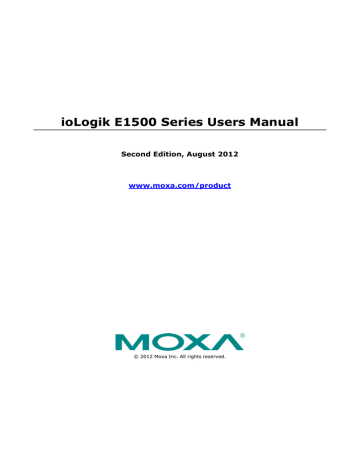advertisement

ioLogik E1500 Series Active OPC Server Utility
OPC Client/Server creates a common interface to connect to different devices
Active OPC Server—From Pull to Push
When looking up an I/O device’s Modbus table, 19 or more steps are required to create a single tag. The steps include specifying the IP address, selecting the protocols, and defining the data type. The procedure is repeated over and over until all the devices and tags are created. It takes about 1 minute for a user with a technical background to create one tag. But what if there are 400 tags in an OPC system? Not only does it take a long time to configure such a large number of tags, it also puts a heavy load on the CPU.
OPC also requires the connected I/O devices to use fixed IP addresses. This type of architecture is sometimes referred to as “pull” technology, because the OPC server always needs to pull data (by “polling”) from the I/O devices for tag creation, IP connection, and tag status updates.
Moxa’s ioLogik Active Ethernet I/O products offer I/O status reports via TCP/UDP messaging, e-mail, and SNMP traps. In addition, they now support OPC technology. An ioLogik can automatically generate tags without requesting any data or even a device’s IP address. All the user needs to do is launch the Active OPC Server program, and the I/O channels selected by the user will be “pushed” from the ioLogik to the Active OPC Server.
5-3
ioLogik E1500 Series Active OPC Server Utility
The “push” technology also includes the update for the tags. When the I/O status changes, the ioLogik will send updates to the Active OPC Server. Compared to polling the status (the so-called pull-based method), this feature efficiently reduces network bandwidth usage and speeds up response time with event-driven, push-based status updates. At the same time, the heartbeat function monitors the system’s basic signs of life.
DI 1=ON
DI 1=OFF
DI 0=ON
DI 0=OFF ioLogik Tag Update ioLogik Idle
Push for tag updates
Heartbeat every X seconds
ioLogik
Active OPC Server
Check every 5 seconds ioLogik Alive ioLogik Not Alive
Heart Beat
5 10 15 20 25 30 35 40 Time (sec)
5-4
advertisement
Related manuals
advertisement
Table of contents
- 6 Overview
- 6 Getting Started
- 6 Basic Configuration
- 6 Software Configuration
- 7 Common Specifications
- 8 ioLogik E1510-T
- 8 ioLogik E1512-T
- 10 Panel Guide
- 10 LED Indicators
- 11 Isolation DI (DI channels)
- 11 DI Circuit (DIO channels)
- 11 DO Circuit (DIO channels)
- 13 Connecting the Power
- 13 Grounding the ioLogik E1500
- 13 Connecting to the Network
- 14 I/O Wiring Diagrams
- 14 DI dry contact mode
- 14 DI wet contact mode (Ch-Ch isolation)
- 15 DI wet contact PNP/NPN mode (No CH-CH isolation)
- 15 DIO_DI wet contact mode (no CH-CH isolation)
- 16 DIO_DO sink mode
- 19 General Settings
- 20 Ethernet Configuration
- 21 Default Address
- 23 DI Channels
- 25 DO Channels
- 27 IP Accessibility
- 27 To allow access to a specific IP address
- 27 To allow access to hosts on a specific subnet
- 27 To allow unrestricted access
- 28 Network Connection
- 28 Firmware Update
- 28 Import System Configuration Settings
- 29 Export System Configuration Settings
- 29 Change Password
- 32 Main Screen Overview
- 33 System
- 34 Sort
- 34 Quick Links
- 35 Locate
- 35 Firmware Upgrade
- 35 Batch Upgrades on Multiple Devices of the Same Model
- 35 Unlock
- 36 Import
- 36 Export
- 37 Change IP Address
- 37 Batch TCP/IP Configuration of Multiple Devices
- 38 Restart System
- 38 Reset to Default
- 39 Mass Deployment (Import)
- 39 Mass Deployment (export)
- 41 Active OPC Server System Requirements
- 41 OLE for Process Control
- 42 Active OPC Server—From Pull to Push
- 44 One Simple Click Creates Active Tags
- 44 Faster, More Accurate Data Collection than Traditional “Pull Technology”
- 45 Installing Active OPC Server
- 45 Main Screen Overview
- 45 Menu Bar
- 45 File
- 46 System
- 47 Sort
- 47 Quick Links
- 49 Fixed & Dynamic Default addresses
- 49 0xxxx Read/Write Coils (Support function 1,5,15)
- 50 1xxxx Read only Coils (Support function 2)
- 51 3xxxx Read only Registers (Support function 4)
- 53 Fixed & Dynamic Default addresses
- 53 0xxxx Read/Write Coils (Support function 1,5,15)
- 54 1xxxx Read only Coils (Support function 2)
- 55 3xxxx Read only Registers (Support function 4)
- 55 4xxxx Read/Write Registers (Support function 3,6,16)
